Node js vs Python: Which Backend Language to Choose?
1. Overview
When it comes to back-end development, Node.js and Python are the two most popular technologies. And choosing one of them is quite challenging and this is because both of them come with their own pros and cons. So, the process of selecting the right technology stack from the most debatable Node.js vs Python depends upon the project’s size, cost, and launch timeline of the app.
This means that when any business organization is planning to hire Nodejs developers or Python developers for its project, it must consider these things and see which technology is more manageable. To know more about these languages, and see which is the best one between Node.js and Python for the next project, let’s go through this blog.
2. What is Node js?

Now, every web developer might know that Node.js was founded by Ryan Dahl and it is excellent for developing both sides- frontend and backend of web applications that run on JavaScript.
Node.js is a JavaScript runtime environment built on the high-performing V8 JavaScript engine of Google. It is one of the vital contributors in boosting the efficiency of Node.js code.
Also, to elaborate, Node.js is event-driven, scalable, and provides incredible project efficiency. Its nature is asynchronous which enables you to process multiple requests concurrently without stopping I/O activities. These activities occur on client and server sides both and thus most development teams prefer Node.js.
2.1 Key Features of Node js
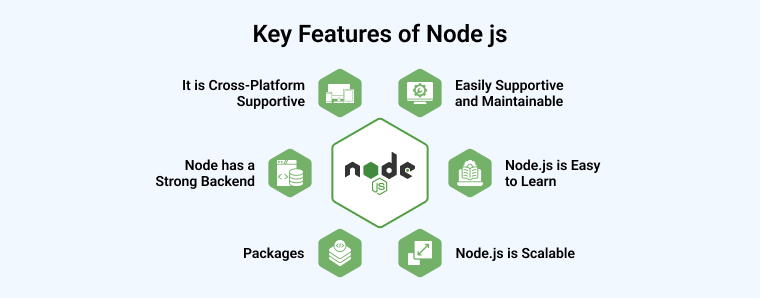
The popular features of Node.js make the development process easier and more efficient. The simple yet effective features of Node.js are enlisted below
- Node.js is Scalable: Node.js is single-threaded, therefore it has the ability to manage bigger projects with large numbers and interlinked connections making it more flexible for any web app. This enhances the scalability to an enormous level. With its non-blocking features, it adds efficiency and speed to node.js app development.
- Packages: A large number of open-source Node.js packages are here to make the development process easier. In today’s NPM ecosystem, there are over one million packages.
- Node has a strong backend that speeds up server execution and adds features like networking, data transfer, and support. This is because Node.js is written in C and C++.
- Node.js is easy to learn: With a plethora of tutorials and vast community support, Node.js is a popular choice among new web developers and it is easy to learn
- It is cross-platform supportive: You may construct websites for SaaS products, desktop apps, and even mobile apps with cross-platform support of Node js.
- Easily supportive and maintainable- As it is used for both the frontend and backend of web applications. Node js is written in javascript code so it can be managed easily.
3. What is Python?

Python is a completely object-oriented programming language with a pretty good level of abstraction. It has a large number of core libraries, APIs, and supplementary development tools because it has been around for nearly 30 years. There are numerous types of programming paradigms that are widely utilized in corporate applications.
It has a large role in communities, library functions, and supporting platforms. As a result, it’s a suitable programming language for most enterprises that need to create robust web applications for a variety of distinct, often unrelated use cases.
3.1 Key Features of Python Programming Language

It’s a high-level programming language that is free because it’s open-source. Python developers can easily learn it from different sources and can also develop Python web applications and contribute it to the language and its packages.
Python code has thousands of modules that allow programmers to quickly create complicated data science apps.
Python is multi-paradigm: This clearly means that it supports OOPS (Object-Oriented Programming) and also the functional and structured programming methods.
Interoperable- Python programs can be written in any language and run on any operating system, including Windows, Mac OS X, and Linux. Python’s syntax is extremely extensible, allowing you to quickly combine it with C, C++, Java, and other languages.
Flexible all across frameworks and User Interface- Python supports a wide range of graphical user interface frameworks. PyQT, Tkinter, and Pygame are some of the most popular Python frameworks. They can be used to make a variety of applications
4. Node js vs Python: In-Depth Comparison
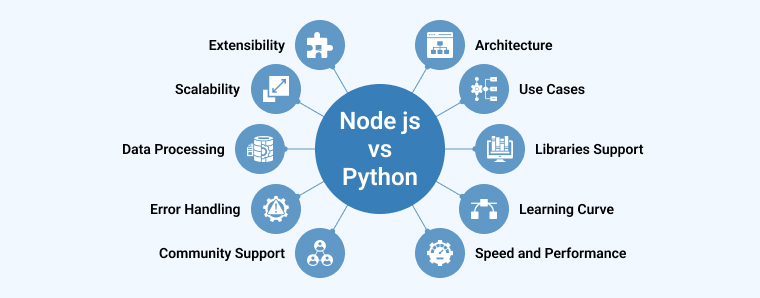
4.1 Scalability
Node.js is already quite scalable because of the runtime environment, it is built-in and the cluster module that the machine is capable of managing. Other than that, Node.js helps you write a massive monolithic core with ease and simplicity. Instead, create a set of microservices and modules, each of which connects via a lightweight mechanism and runs its own process. The development process is flexible since you may easily add any additional microservice or even module. When it comes to python, it is also a good option since it is built on a strongly-typed TypeScript.
Multithreading must be enabled in order to scale a program. However, because it uses the Global Interpreter Lock, Python does not support multithreading (GIL). Python provides multithreading libraries, however, they are not “real” multithreading. GIL allows the Python interpreter to run just one thread at a time, even if there are numerous threads. Python is forced to use GIL, despite the fact that it degrades speed because python’s memory management is not thread-safe.
Python’s type system is also dynamic. Dynamically typed languages, on the other hand, are not appropriate for large projects with expanding development teams. The system becomes increasingly complex and difficult to manage as it grows in size.
4.2 Speed and Performance
First and foremost, Node.js is extremely fast due to the V8 engine’s translation of JavaScript code. Furthermore, because Node.js executes code outside of the browser, the app uses fewer resources and performs better. It also allows you to leverage technologies such as TCP sockets that aren’t supported by browsers. As a result, the event-driven non-blocking design enables for the processing of several requests at the same time, resulting in faster code execution. Finally, Node.js offers single module caching, which enhances responsiveness and speeds up app loading.
Node.js is developed using Javascript, while if we compare both other languages like Python and JavaScript they are slower than Node. But Python is a single-flow language which means requests are not handled slowly, it’s faster than Node. Python is thus unsuitable for projects that place a premium on speed and efficiency or that involve a large number of complex calculations.
4.3 Extensibility
Node.js is simple to adapt, expand, and combine with a variety of technologies. It can be customized by using built-in APIs to create HTTP or DNS servers. It can be used in conjunction with its JS compiler (example babel) to make web app development easier with older versions of Node or the browser. It is quite handy and can be used easily for unit testing, project monitoring, and troubleshooting. Migrate, PM2, and Webpack- all of these can be used for migrating data, managing processes, and module collecting.
Some of the popular extensions of Node.js are Express, Koa, Hapi, Fastify, Meteor, Restify, and more frameworks that can help in expanding the Node.js framework.
Now when it comes to Python, it is equally compatible with other extensions and plugins. You can use Python with all popular code editors and also with additional editing tools and syntactic extensions. You can also access the test automation framework. Web2Py, Django, Flask, and Pyramid, are just a few of the sophisticated web development frameworks available.
As a result, both networks are easily expandable and win a point.
4.4 Libraries Support

NodeJS has NPM – the Node Package Manager – that manages all the inbuilt UI libraries and packages available for functioning in Node.js. It is one of the largest software library repositories. NPM is easy to learn and document.

Python and Pip are closely related. Pip is the Python library and package manager. Pip is quick, dependable, and simple to use, making it simple for developers to pick up.
4.5 Community Support
There isn’t any point in underestimating Node.js as its development took place recently. It is a myth if you think Node.js is a newer technology, and its community is small. It’s surprising to hear that the Node.js community is quite extensive and active globally, with well-experienced Node.js Developers. In the Node.js community, it’s really easy to spot talent.

Node js has 93.8k stars and 25.4k forks in Github which make it one of the most popular Javascript Library.
Python has a larger community because it was first invented among the two tech stacks. Python has a wealth of talent at all levels, from junior to veteran, there are experts contributors. One of the most significant benefits of a large community and easily available developers. And these developers’ active participation leads to quick fixes and overall language improvement.

As you can see in the above image, Python has very huge community support on GitHub with 155k stars and 39.3k forks.
4.6 Learning Scope
With a deep familiarity with Javascript, it wouldn’t be incorrect to say that the learning curve for Node.js isn’t too severe. You cannot learn it easily. As Node.js is event-driven programming it is easy to install and document. The process is not that challenging. This approach to Node.js’ scalability and efficiency is not steep, but it is easy to learn. If you’re a new developer, though, event-driven programming may take some time to master. However, once this is over, understanding Node.js is practically painless. Learning Node js isn’t that easy as it looks but if you are stuck anywhere while building a web app then you can seek help from Stackoverflow. Node’s community on Stack Overflow would help you out.

The major focal point of Python has always been its universally accepted and simple syntax. The code length in Python is shorter than in Node.js or other programming languages and even in the runtime environments’. The codes written in Python are crisp and easy to understand.
4.7 Error Handling
The error handling in both types is almost the same. This means they both are at their best when it comes to error handling. Talking about Node.js then there is a parallel-process-running functionality in Node.js that can make detecting bugs and problems in code less time-consuming. Standard JavaScript errors such as SyntaxError, RangeError, EvalError, TypeError, ReferenceError,, and URIError are common in Node. js applications.
When looking for problems and errors in the code, Python can offer simpler syntax, and the lack of parallel processes helps. Although it does not process in parallel, it is capable of detecting and reporting outright errors at the appropriate time.
4.8 Data Processing
For data processing tasks it is important that you have good control over the data environment with more data-processing power. This makes the environment automatic, more efficient, and adaptable. If there is a case where your app uses a lot of data, Node.js should be your first choice.

As we can see in the above image, the technology of the runtime environment makes it ideal for programs that need to transmit and manage a large amount of data. Due to its parallel running and seamless I/O operations, Node.js is the more efficient contender here.
Python is sluggish in processing data because it has a basic syntax and just one thread running at a time. Python can accept a variety of encoding strategies, but you must load different sorts of modules to make them function. Let’s see how data processing is done in Python.
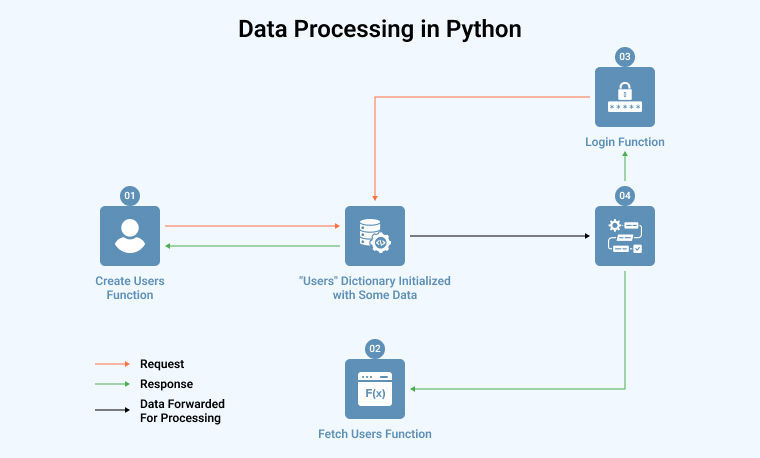
4.9 Architecture
The term “software architecture” is used to describe the overall framework of a program. In other terms, it describes how the program operates. Each structure is made up of software components, their relationships, and their attributes. For big applications, effective architecture is essential. If not, the system would eventually become more complicated and costly to add additional functionalities. Here’s Node js architecture.
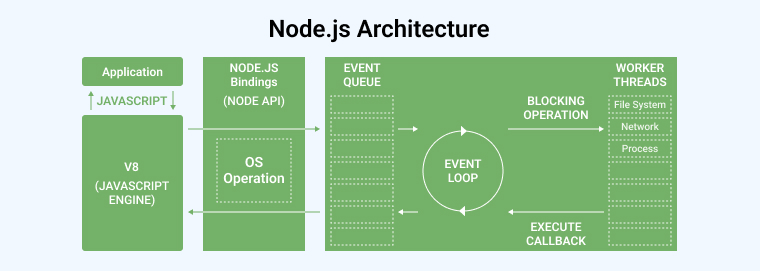
To manage numerous clients simultaneously, Node.js employs the single-threaded event loop approach. Task execution is sped up by using fewer threads and resources altogether. Node.js is ideal for real-time applications because of its non-blocking nature, which enables it to manage hundreds of simultaneous connections.
Node.js and Python operate in distinct ways. First off, Python does not immediately translate its code into machine code. Rather, it generates bytecode that must be interpreted in order to become machine code. Furthermore, Python does not allow multiple threads. Nevertheless, with modules like asyncio, you may create asynchronous and event-driven apps.
4.10 Use Cases
There are many use cases that can fall convenient and apt for Node.js. One of them is because Node js works as an event-based architecture. Node.js is best suitable for real-time web applications with several concurrent requests. The following are just a few of the numerous applications that use Node.js:
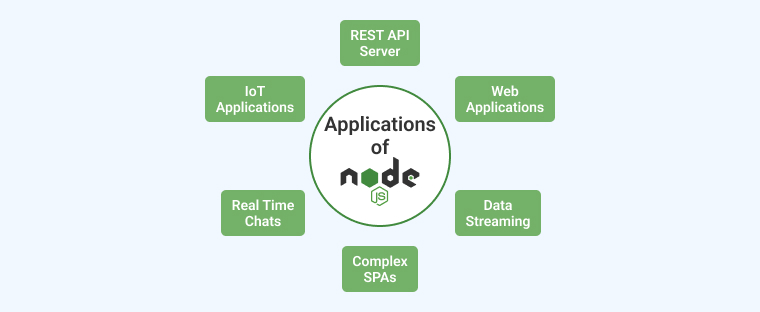
- I/O-dependent applications
- Applications that stream data
- Real-time, data-intensive applications (DIRT)
- Applications that use the JSON API
- Applications that are only one page long
Speaking of Python, it is a significant programming language to learn which strategically utilizes all of its popularity. Its extensive libraries make it simple to create and launch an MVP. This also guarantees that web developer resources make full utilization of their potential when using Python. With frameworks like Django and Flask, Python also allows web development of AI and Machine Learning, you can use Python to construct desktop and commercial applications, as well as games. Python is a popular programming language for
- Data science applications
- Data analysis and visualization
- Image processing software
- Neural networks
- Machine learning systems.
5. Most Popular Apps Built With Node js and Python
- Netflix
Netflix’s creators wanted a rapid, adaptable, and responsive program, so they opted to utilize Node.js for the interface’s development. Netflix’s web application load times have decreased by 70% when they began using Node js.
- Uber
One of the first major companies to begin using Node Js in product development is Uber. Uber’s efficiency and responsiveness have both improved greatly when the company began using Node.js.
- PayPal
PayPal The primary motivation for picking Node Js was the ability to use JavaScript for both client-side and server-side applications.
]For improved application speed, LinkedIn, a leading professional social networking site, has opted for Node.js.
6. Final thoughts on Node.js vs Python: Which one is more popular?
In the end, there are programmers and developing businesses sure about using one of the technologies but then due to lack of clarity hold themselves back. Every programming language has its own pros and cons and in some business scenarios, some languages may work well, while in others, they may not. As a result, it’s critical to know what your project’s goal and needs are. On that basis, you are free to select a language. This strategy will also improve your chances of success.
So, if you’re working on a project, be sure you know what you want in terms of requirements, features, and benefits. After that, write a list of all the requirements and decide which technology would be most effective.
7. FAQs
5.1 Which is Faster? Node js or Python.
One, Node.js is much quicker than Python. Rapid execution is achieved thanks to Node.js’s direct compilation into machine code. Python is more sluggish than Node.js since it processes requests in a linear manner using single-flow techniques.
5.2 Can you use Node js with Python?
They may be used concurrently with the right equipment and some creative solutions. While JavaScript may be utilized, Node.js is preferred.
5.3 Is Python slower than Node js?
Unlike Node.js, Python processes requests at a slower pace due to its single-flow architecture and the sequential manner in which it performs statements. But, Node.js is quicker since it utilizes the V8 engine to understand the codes.

Hardik Dhanani has a strong technical proficiency and domain expertise which comes by managing multiple development projects of clients from different demographics. Hardik helps clients gain added-advantage over compliance and technological trends. He is one of the core members of the technical analysis team.
Magento is one of the most popular eCommerce platforms in the industry and this is because of its features and regular updates. The main reason...
 May 4, 2022
May 4, 2022 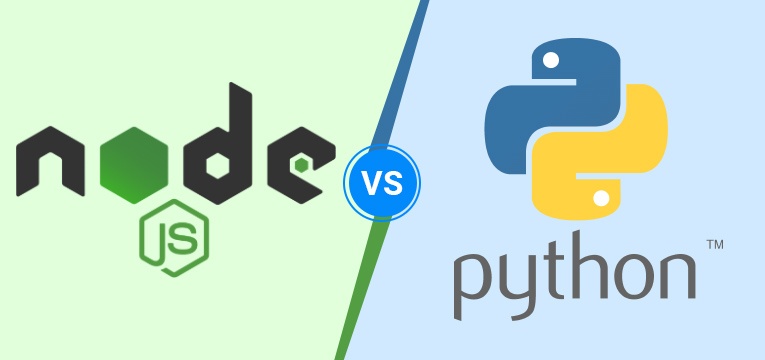



Thank you so much for sharing this amazing piece of blog. I really like the way you demonstrated both of the tech stacks with their benefits and limitations. After reading this, one can easily choose which which one is best suitable for their project.
After working with both the technologies, I can easily say that Python is gaining more popularity in today's era because it has capabilities to create AI and ML, while Node js is more straight forward backend development framework. Indeed you did nice work to differentiate both of this. Thanks!